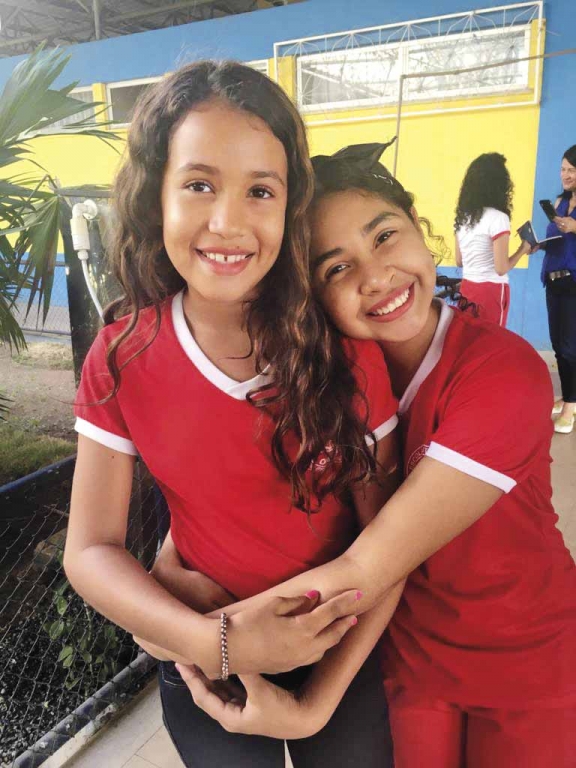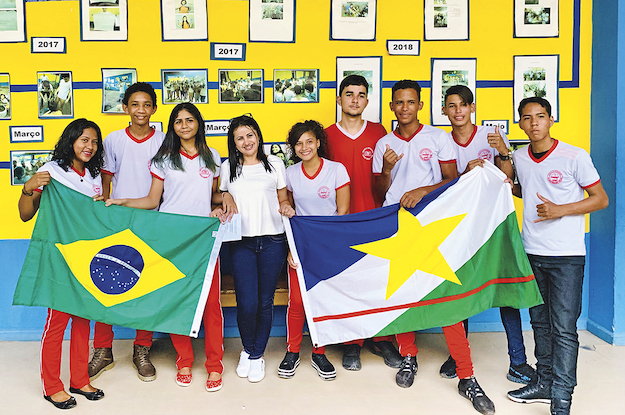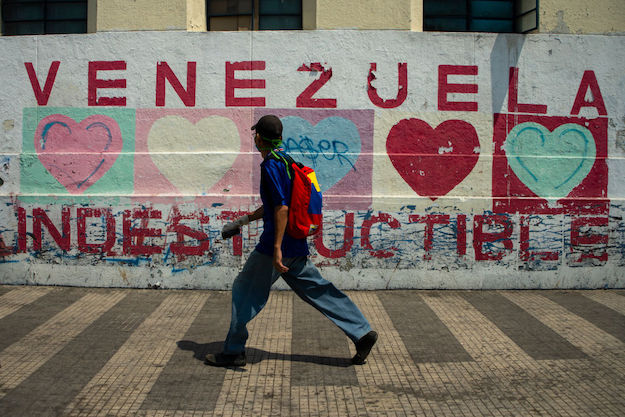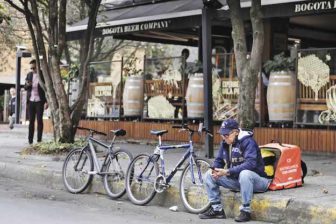This article is adapted from AQ’s special report on migration | Ler em português | Leer en español
BOA VISTA, Brazil — The moment you walk into the Olavo Brasil Filho school in this sleepy Amazon city, you know something unusual is happening.
“Love your neighbor — If you can’t manage that, at least respect them,” said one sign hung from the wall.
“Two cultures, one nation,” read another.
“Your presence fills us with happiness,” a third said, written around a bright red heart.
Just three years ago, the school had only six students from Venezuela. But that increased to 63 by 2019, and by the time I visited in early 2020, 92 of the school’s 859 students had come from across the border. The surge mirrors a trend seen across much of South America — putting enormous strain on services, including schools, which are still figuring out how to assimilate the new arrivals.
Unlike elsewhere on the continent, the language in Brazil is a significant barrier for incoming Venezuelans. And kids are definitely not immune from the xenophobia often seen in society at large. But teachers are still doing their best to make migrants feel at home — and the signs on the wall are just a small part of the effort. Simone Catão, 43, a charismatic math teacher who seemed to bounce with enthusiasm at every word, is behind the integration drive. “At the beginning the Venezuelans here had such low self-esteem, and the not-so-nice games that adolescents tend to play didn’t help. We had to make them feel welcome,” said Catão.
Catão’s methods include adding hyperinflation and the complexities of Venezuela’s exchange rate system to her usual lessons. “I said to the kids, let’s do some comparisons: How much does a kilo of meat cost here and how much in Venezuela? Would your family be able to buy meat if you were in Venezuela?”
She has also urged students to help one another with Spanish and Portuguese, and share their cultural heritage. In an improvised garden in the school’s courtyard, students have planted mint, parsley, and orange and pomegranate trees with neatly spelled-out labels in Portuguese and Spanish. The school canteen has started to serve Venezuelan arepas, Brazilian students teach newcomers drum rhythms, while Venezuelan parents have been invited to teach their traditional dance, the joropo.
Are such efforts working?
Well, as the kids here will tell you — it’s complicated.
But it’s also obvious that the integration effort in Roraima state, and places like it all over Latin America, is just getting started.
New friends — but some bullies, too
Like many other countries, Brazil officially closed its borders to Venezuela amid the coronavirus pandemic in March. But most experts expect the flow of people to continue across a border that is mostly jungle and extremely difficult, in practice, to seal off. Even if the flow were to suddenly stop, more than 60,000 Venezuelans are already living in Roraima state, raising the state’s population by more than 10%.
Most have fled poorer eastern regions of Venezuela such as Anzoategui, only to arrive in what is Brazil’s poorest state by GDP. The impact on virtually every aspect of life has been immense. Unemployment in Roraima has more than doubled. Lines at hospitals and clinics have lengthened. Homicides are down, but petty crimes and robberies are up. And during a two-week visit talking to dozens of teachers, parents, students and administrators, the strain on the education system was evident.
In 2019, more than 10,000 students were enrolled in Roraima state’s schools, more than three times more than the previous year, propelled by the flow of families crossing the border. “This situation has been way outside our expectations,” said Leila Soares de Souza Perussolo, the state’s education secretary.
The biggest challenges, of course, are faced by Venezuelans themselves. For 12-year-old Alvin Malave, adjusting to life in his new adopted home here in northern Brazil has been hard.
“He is less nervous now but it has been quite emotional,” said his mother, Malvin Malave, 45, who has found casual work as a manicurist. She and her husband, who does the odd painting and building job, are “surviving,” she told AQ.
Schooling was one of the main factors that brought Malave to Brazil last year. In spite of food shortages, the mother of three was reluctant to leave her grown-up children behind, but said her young son’s education prospects were deteriorating rapidly. “There were no teachers. They had all resigned. They make more money selling things on the street,” she said.
Malave had been encouraged by the fact that her nine-year-old niece, who moved to Boa Vista two years earlier, had picked up Portuguese quickly. But for Alvin, a shy boy who prefers tennis to the Brazilian obsession of soccer, it has been harder going.
Slowly eating his way through a tub of frozen açaí, a popular Amazon fruit that Brazilians eat like ice cream, Alvin told me he liked history and science classes but that Portuguese was difficult to learn, and that he had not been able to make Brazilian friends. “They are a little closed,” he said.
Dilmaris Carolina Durán, a 31-year-old hairdresser from Isla Margarita, arrived in Brazil last year, but her four youngest children have yet to find a place in local elementary schools. José Gregorio, her 14-year-old son, just started secondary school but has to walk an hour and a half to go to class. Many Brazilians have been resentful of new arrivals, with local students reluctant to mix with the newcomers or in some cases outright bullying them.
“I left my first school. The kids started pinching me,” said Yoriexi Gloirisbel Pena Cordero, a 12-year-old who left her home in El Tigre two years ago. “It was horrible.”

Kids will be kids
Yet when I spoke to both Venezuelan and Brazilian students at the Olavo Brasil Filho school, almost all the chatter was upbeat. First I met with 11- and 12-year-olds, and later with teenagers between 15 and 17, and kids were all competing with one another to say favorable things.
“They call us venecos,” laughed Luis Alfonso Gobaria Gonsalvez, 15, who came from Venezuela in 2017. “But I have felt no prejudice at all. I was made to feel really welcome and I have Brazilian friends.” Danielle Santana Araujo, a 16-year-old Roraima native, said that after a rocky start, things had improved at school. “Brazilians and Venezuelans tended to be in separate groups. But things got better, especially when they started to speak Portuguese.”
Several younger Brazilians were anxious to share poems they had written for a competition the school held last year. “I’m human not an animal, I’m a refugee looking for a place to stay,” recited Karina Freira da Silva, an earnest 11-year-old.
Afterward, she said into my phone camera, “We will help them. They can count on us.”
Yasmin Camille Costa, a 12-year-old from Boa Vista, and her best friend, Sofía Ginet Rodríguez, who arrived from the Venezuelan town of San Félix two years ago, happily posed for photos arm in arm. “There is a lot of prejudice, but it is diminishing. We are all friends now,” said Costa.
A few miles away, close to the center of Boa Vista, is Lobo D’Almada school. There, teacher Maria Bernadete Oliveira started an initiative against bullying and discrimination. “We wanted to make the Venezuelan kids feel welcome at the school,” said Oliveira, 47. Like Catão, Oliveira wants to persuade other schools to adopt similar schemes.
But resources available to schools have simply been inadequate to meet demand. Funding for education is adjusted according to the number of students in the system. However, the budget is calculated according to enrollment in the previous year. With the number of Venezuelan students rising so quickly, school administrators are struggling to keep pace.
Much of the good work I saw is dependent on the goodwill and energy of teachers such as Catão and Oliveira. An irrepressible source of energy, Catão said she had to persuade fellow teachers to participate. “It was a lot of work at the start, but in the end everyone in the school is taking part,” she said. With money donated by a local politician, Catão was able to publish a small booklet, Two Cultures and One Nation, detailing the projects they had developed, to try to get other schools to adopt the idea. “Progress is really down to the efforts of individuals,” said João Paulo Pires, a local journalist and editor of the Correio de Lavrado website.
Nerves wear thin
The federal government is funding the emergency reception of migrants through a program dubbed Operação Acolhida (Operation Welcome) managed by the army. Some $40 million in funds were allocated in 2019 and a further $65 million in 2020 for 11 emergency camps in Boa Vista and the border town of Pacaraima. Nearly 6,000 Venezuelans are housed in tidy rows of specially designed shacks made from lightweight steel and heat-resistant plastics.
The army also partners with agencies to help migrants find homes and jobs in the better-off southern regions of Brazil, and some 33,000 Venezuelans have relocated in the last two years. But the number of migrants crossing the border had still been rising. Colonel Carlos Cinelli, chief of staff at Operação Acolhida, told AQ that an average of 523 Venezuelans a day came into Brazil through Pacaraima during 2019. They tend to come from more isolated eastern and southern regions of the country and generally have fewer family connections in Brazil than other migrants.
This is all a big concern for Roraima’s governor, Antonio Denarium, who, during his campaign for governor had defended closing the border. In late 2018, the impact of the wave of migration had pushed Roraima into crisis, forcing his predecessor, Suely Campos, to stop paying civil servants. That in turn triggered a strike by the police and a short-lived and unprecedented federal intervention in the state. Denarium, a farmer and one of two state governors to join President Jair Bolsonaro’s new right-wing party, the Alliance for Brazil, told AQ that his administration had been able to bring the state’s accounts back into the black.
But he claims that health care, education and security for Venezuelans is costing Roraima the equivalent of 10% of its annual budget. Indeed, the state is taking legal action to recover the money from the federal government. “There are a lot of Venezuelans here in Boa Vista and this is having an impact on our public services. The population of Roraima is very hospitable, but there is a limit,” he said. “[People here see] everything that comes from Brasilia is for the Venezuelans and nothing for them. They are getting really fed up.”
Violence between Brazilians and Venezuelans has been mercifully rare. The last major incident happened in August 2018 when a group of residents of Pacaraima destroyed a camp, forcing more than 1,000 migrants back over the border.
But there is plenty of evidence of low-level discrimination. I heard stories about restaurant customers who didn’t want to be served by Venezuelan waiters and small businesses refusing to employ Venezuelan workers. Malave, the Venezuelan manicurist, became tearful as she described similar experiences. “There is a lot of xenophobia here. I have these experiences and I feel undermined,” she said.
Back at the Olavo Brasil Filho school, amid all the optimism, the governor’s argument resonates. “Many Brazilians feel they don’t get the same benefits as the Venezuelans and that they are losing out,” said Somara da Silva, who is 16. “We tell people here that the majority of Venezuelans are good people. Even so, a state can’t absorb a whole country. We like the Venezuelans but the state is overloaded. It has to be controlled.”








